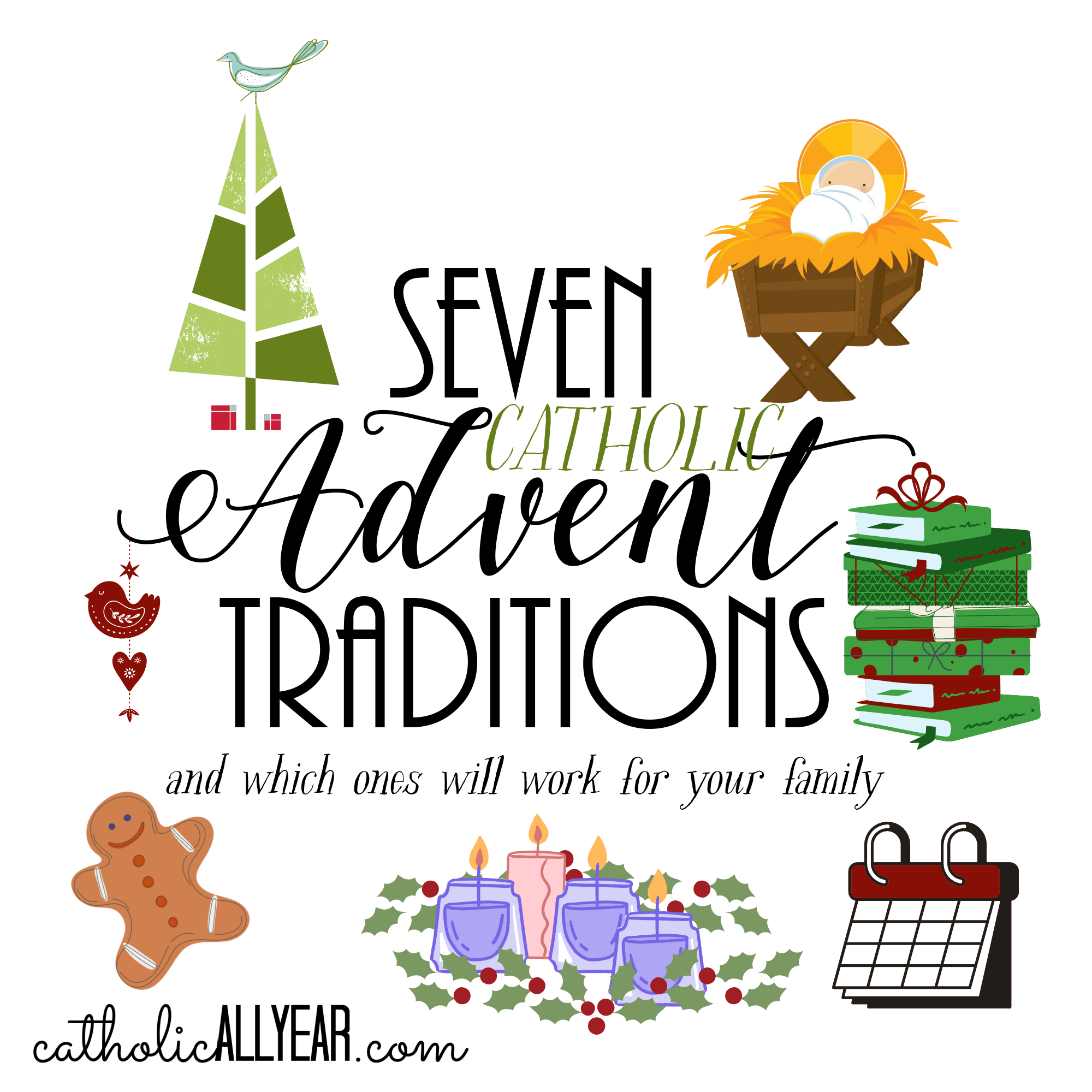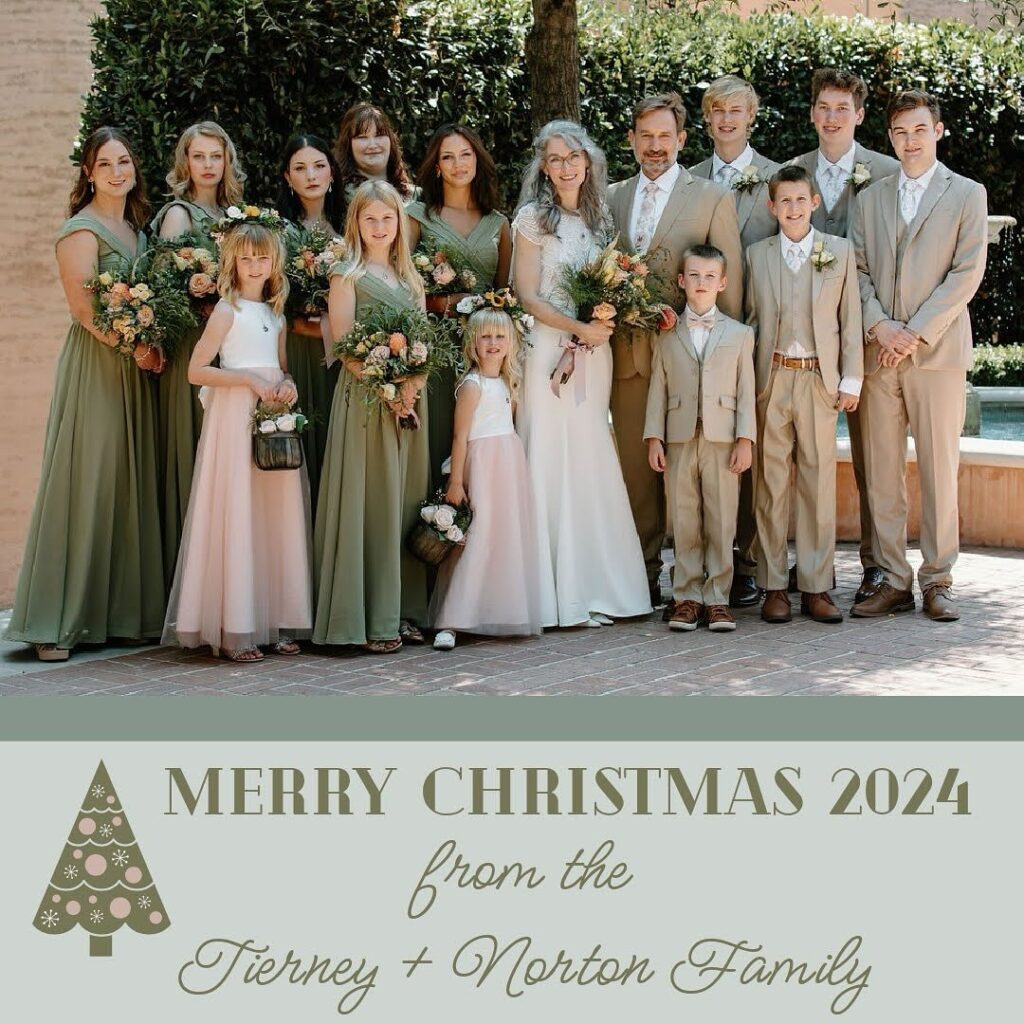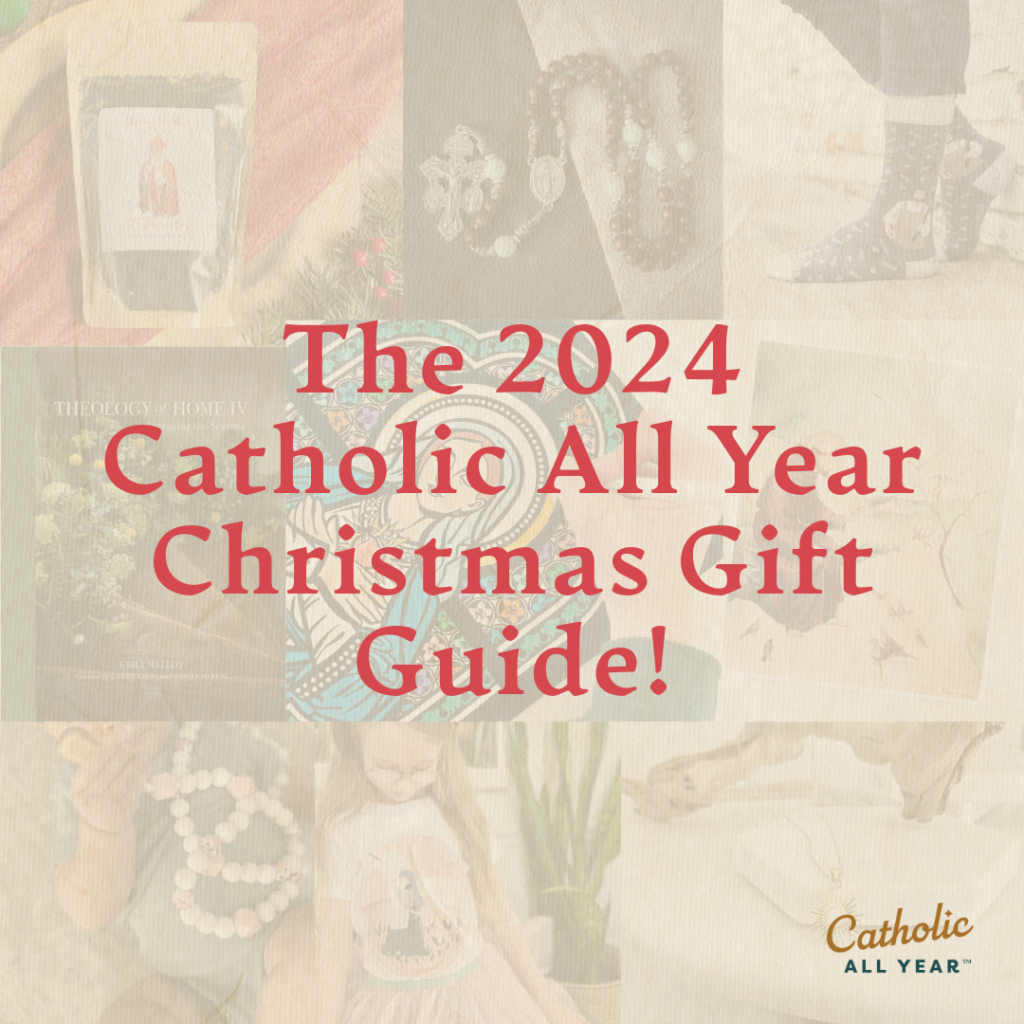Advent is coming! What to do, what NOT to do . . . these are the questions. I think I can help. Here are my seven favorite Catholic Advent traditions with pros and cons of each to help you decide which ones will work for your family and personal circumstances this year.
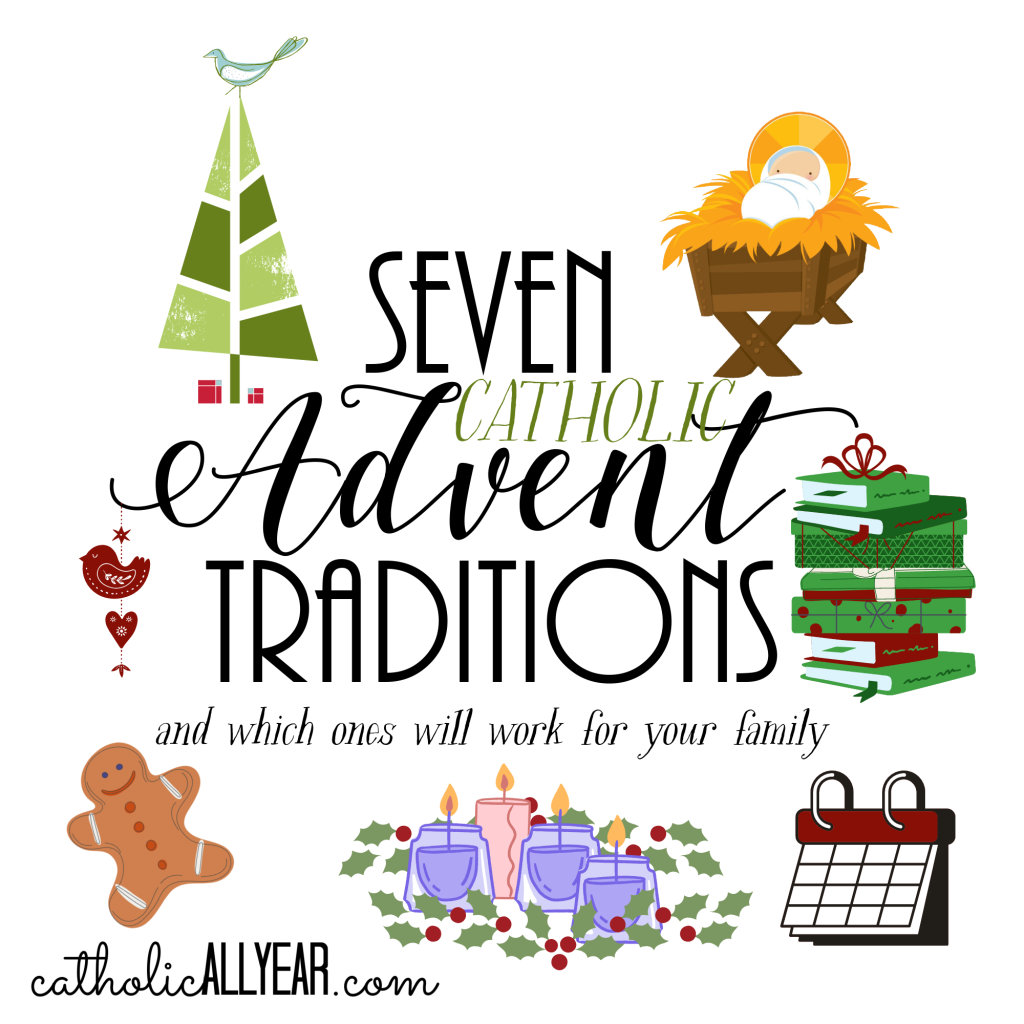
I’m about to launch into a little description of seven different Advent season traditions. This coming Advent, I expect that our family will do all of them. Hopefully you will read these and think, “Hey, those sound meaningful and manageable. Let’s do this.” But maybe you will think, “Hey that sounds like a lot. No way am I doing it all.” I get that. That is a reasonable reaction.
We didn’t always observe all of these traditions in our home. We started small and worked our way up. In years when I’ve been sick and pregnant, or the year Advent started in the midst of a long hospital stay for one of our kids, things have been, obviously, more pared back. I hope what you’ll take away from this post is that the most important concept in all of this is to DO SOMETHING in your home for Advent. Something. Set this season apart from the rest of the year and differentiate it from the Christmas season in a way that’s clear to you and your kids.
Would it help if a box full of my favorite Catholic Advent traditions just showed up on your doorstep? That can happen. Click here.
1. ADVENT CALENDARS
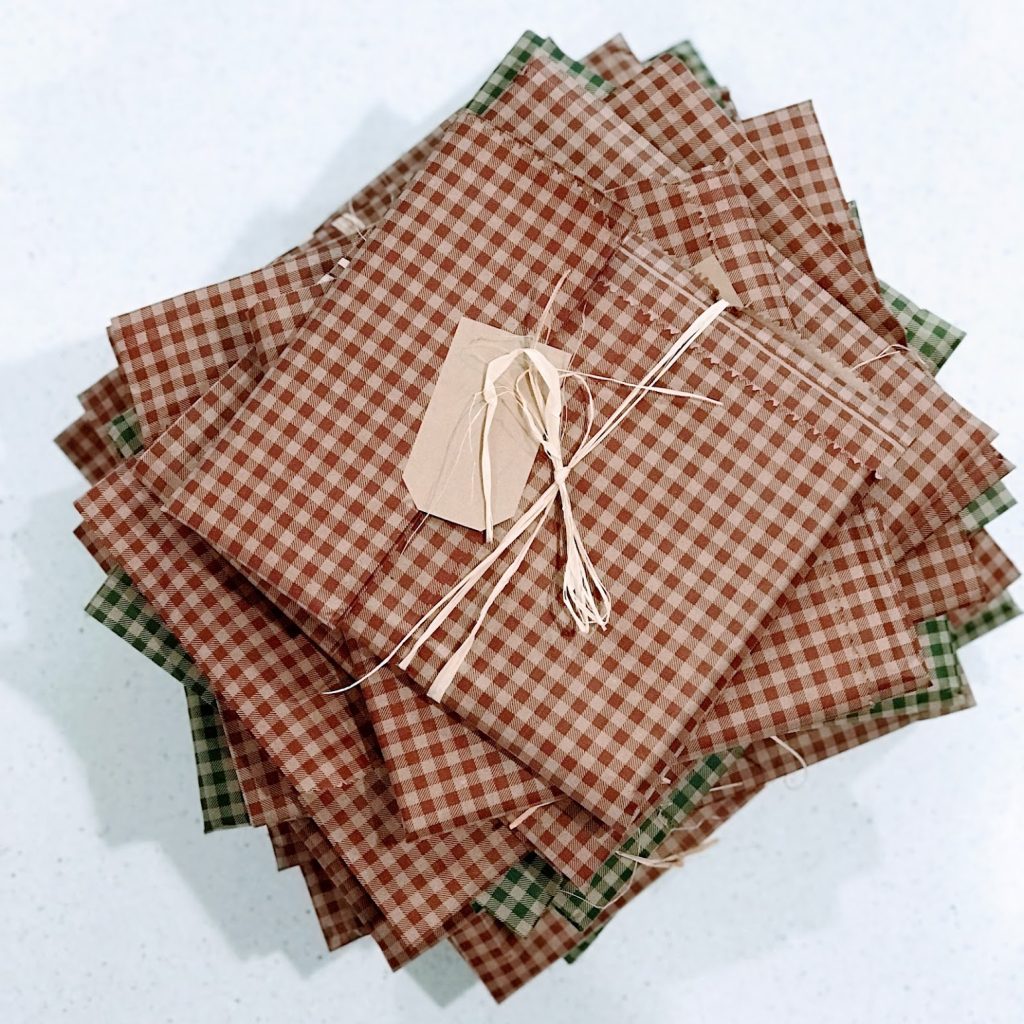
PROS of an Advent Calendar are: it’s super quick and easy, it can be homemade or store-bought, cheap or fancy, and it’s whole goal is the whole point . . . to remind us that it’s Advent every day
CONS of an Advent Calendar are: if you have multiple kids, you’ll either need multiple calendars or a system of turn-taking, the LEGO ones, in particular, take up a ton of space and can be untidy, so consider that when making your choice of type, but overall this one is a no brainer. Definitely do it!
Okay. Number one on the list is: an Advent Calendar. When you are observing Advent as a time of waiting, your kids are sure to want to know HOW MUCH LONGER?! They will probably want to know how much longer a couple times per day. A good way to acknowledge that yearning desire for knowledge, and thwart at least a few of the questions, is to have an Advent calendar (or ten) around the house.
There are dozens of different types from which to choose, homemade or store bought, disposable or reusable, and we’ve had quite a few over the years. The key, I think, is finding one that encourages the spirit of waiting and preparing we are hoping to foster, rather than a spirit of receiving.
Early on we tried those little “open the door” eat a piece of chocolate every day-style calendars. But when Christmas arrived, all the kids had to show for Advent was a piece of trash and a hankering for chocolate every morning. Now, we prefer Advent calendars that build to something, or that actually build something. I like any calendar that lets you add something to a scene each day. There are paper and sticker and wooden and felt and even LEGO versions of this type of Advent Calendar.
And all it has to require of a busy mom is a place to put it.
We usually have many Advent Calendars up around the house. My newest favorite iteration is the wrapped picture book Advent Calendar. We choose 24 Christmas/Advent/winter picture books, wrap them and stack them. Then each evening, the kids unwrap one, we read it, and add it to our basket of seasonal books. These can be new books or even books from the library, but we usually just use books we already own. It’s really a cute tradition that encourages reading together AND helps define the season. Looking to add to your library? Some of our favorite books are in this post.
So many cute versions of Advent Calendars! Paper, felt, wood, charm bracelet, mini tree, LEGO, sticker, or use a Jesse Tree set as an Advent calendar that makes a beautiful image.
2. ADVENT WREATHS
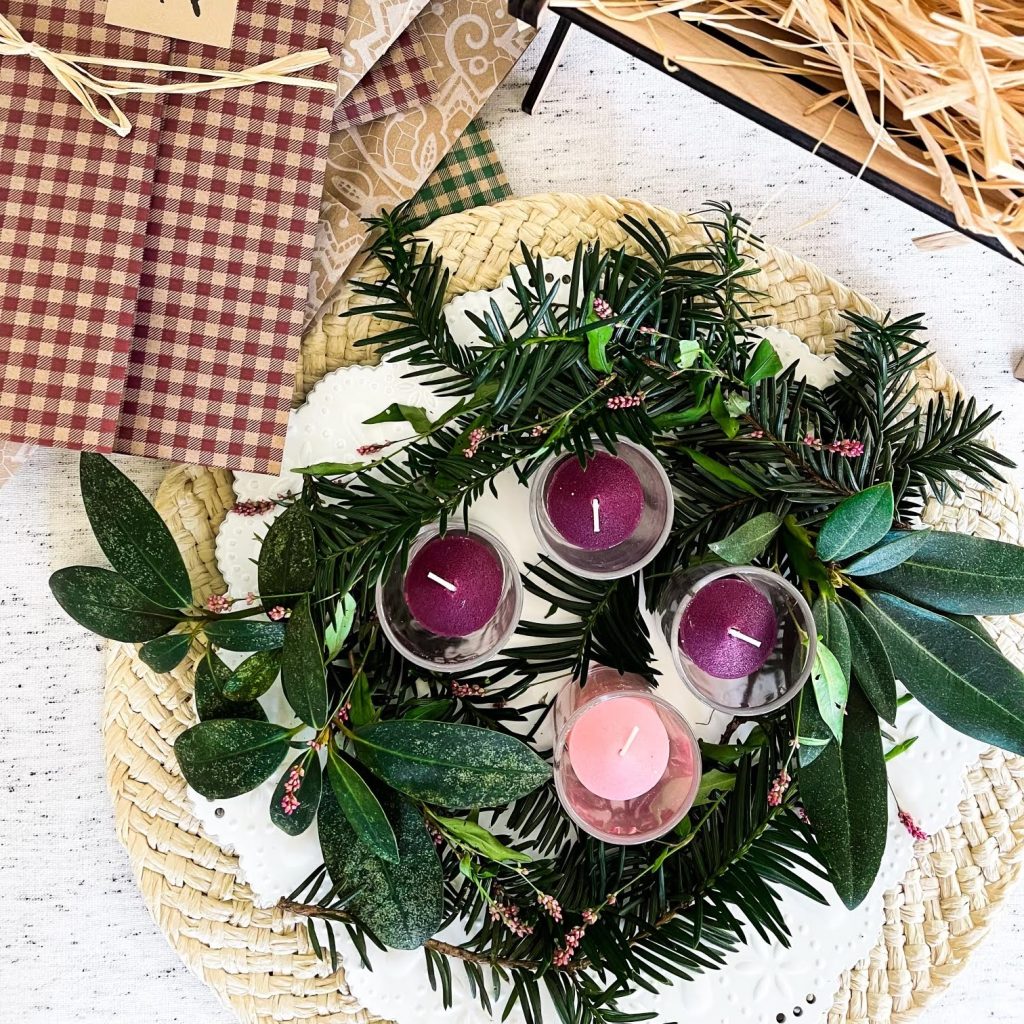
PROS of an Advent Wreath are: it’s a beautiful prayerful tradition that takes very little time; it’s simple to create at home; you get that full sensory experience of prayer, sight, and smell
CONS of an Advent Wreath are: it involves fire and branches so there’s the potential for mess and danger. Mary Reed Newland, one of the OG 1960s mom liturgical living advocates, would hang her wreath over the table from the ceiling to keep it away from little hands. It can be hard to find time during the day with the whole family together, but MAKING that time is definitely a pro.
Number two is the Advent Wreath! I have very strong memories of our family Advent wreath when I was growing up. Perhaps it’s because that was really the only “liturgical living in the home” tradition my family observed, or maybe it’s because I was a preteen in the late eighties and had a very hairsprayed two-layers-of-bangs-hairdo thing happening, that I once set ablaze leaning over a lit front candle to light a back candle. Not a good technique, but memorable. Fortunately, it didn’t sour me on the tradition. There’s something really magical about the smell of the greenery and the flickering candlelight and the repetition of the prayers each evening, as we slowly build to Christmas.
An Advent wreath is a beautiful way to talk about the idea of religious symbolism with kids. The circle of the wreath, with no beginning and no end, symbolizes God’s eternal nature. The evergreen branches symbolize the immortality of the soul. Decorative pine cones or seed pods symbolize new life and resurrection. The four candles symbolize the four weeks of the Advent season, but also the four thousand years from the creation of Adam and Eve to the birth of Jesus Christ. (As time is reckoned in the Bible, which might not be meant literally.) The candle flames symbolize the light of Christ.
When choosing or creating an Advent wreath for your home, it’s good to be mindful of all that great symbolism associated with the traditional shape and materials, so you don’t accidentally end up with one that’s missing any of it.
Also good to remember: there is a strong preference (but not an official mandate) in various Church documents for the use of natural rather than artificial materials for religious purposes whenever possible. “Fake” greenery and “fake” candles are not ideal for use in a sacramental.
My kids and I just go out and cut whatever greenery we can find in the yard to create our wreath. DIY anything with kids can be overwhelming, but this one really is pretty easy. Even very young kids can successfully create an Advent wreath with just a little help.
Make a simple DIY Advent wreath! See the video here.
Jar candles or votive candles in a glass holder make it simple and tidy. The youngest kids get to light candles with help from a grown up, but by the time they are five or six, most of my kids have been able to learn to light candles themselves without incident, and they take a lot of pride in it. And we always teach them to light the back candle before the front one. And to take it easy on the hairspray.
The traditional Advent wreath prayers can be found online and in Catholic prayer books. We say the prayer and light the candle or candles together as a family each night before dinner. We keep the candles burning throughout the meal.
3. THE CHRISTMAS ANTICIPATION PRAYER
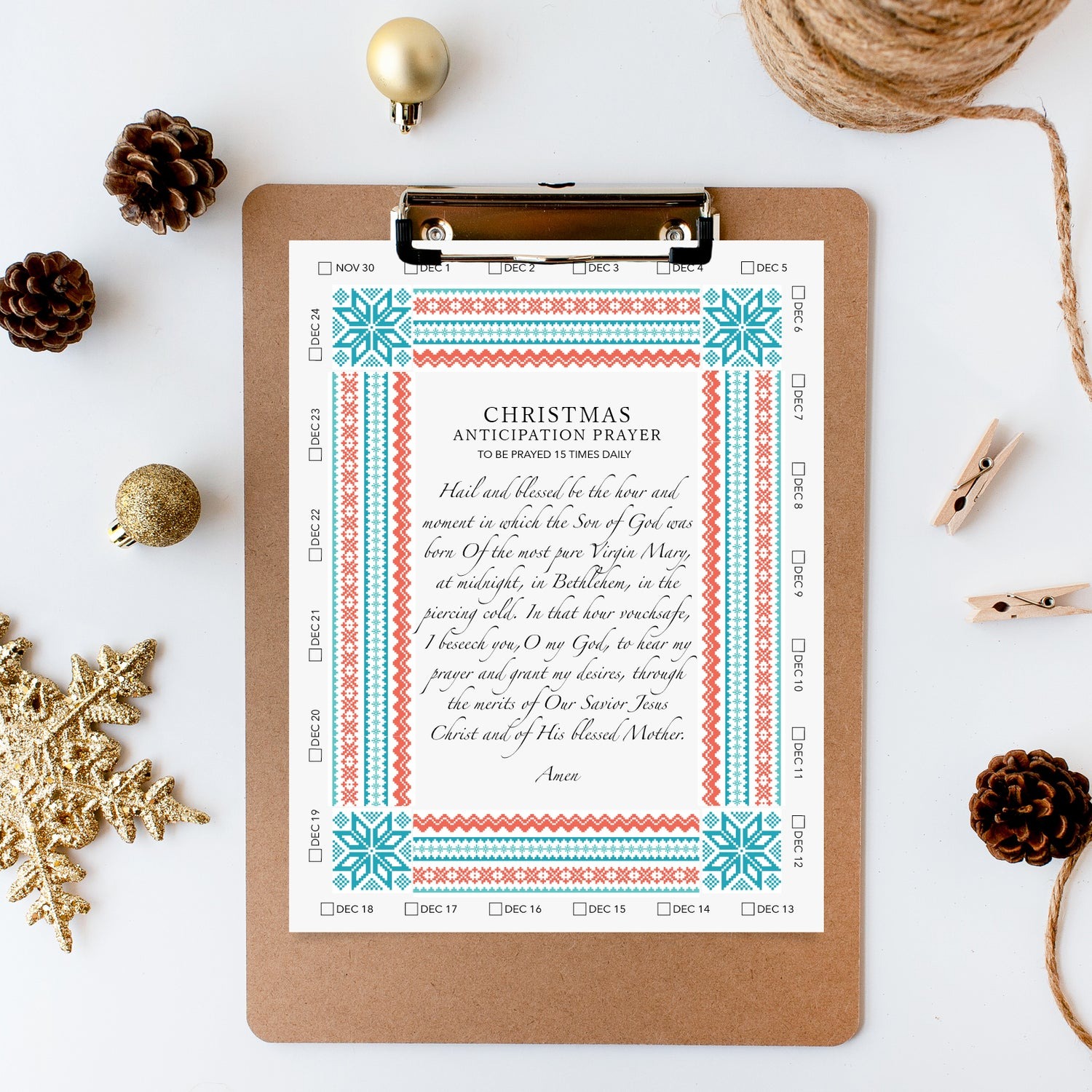
PROS of the Christmas Anticipation Prayer are: it’s easy to memorize, it can be done anywhere, at home or in the car, while doing the dishes, etc., the prayers can be offered for a particular intention, which gives even more meaning to the season, the prayers can be done all at once, or spread through the day, it feels like a real accomplishment if you manage it
CONS of the Christmas Anticipation Prayer are: it can be hard to remember and frustrating when you don’t. My advice is to set a timer on your phone at a time when you think you’ll be able to manage it, then a backup in case something pulls you away. And don’t stress if you miss a day. It’s not a magic spell. It’s an attempt to create a habit and to grow in personal holiness. If you miss a day, you can make it up the next day, or just skip it and try to do better in the future. It’s okay.
Number 3 is the Christmas Anticipation Prayer, also known as the St. Andrew Christmas Novena . . . which is confusing because it’s not a novena (which is a prayer said for nine days straight) and it doesn’t really have anything to do with St. Andrew, other than that it’s traditionally recited fifteen times per day, beginning on his feast day and ending on Christmas Eve.
Grab your prayer and cling combo here!
If you’re looking to level up to something a bit more challenging, I think this is a great tradition to try. The prayer itself always always gets me right in the gut. I love it. Somehow it makes it all feel so real to me, how Christmas was an actual historical event, this one amazing moment in time, in which a very special baby was born to a very special mother, in very humble surroundings.
4. A GRADUAL APPROACH TO DECORATING
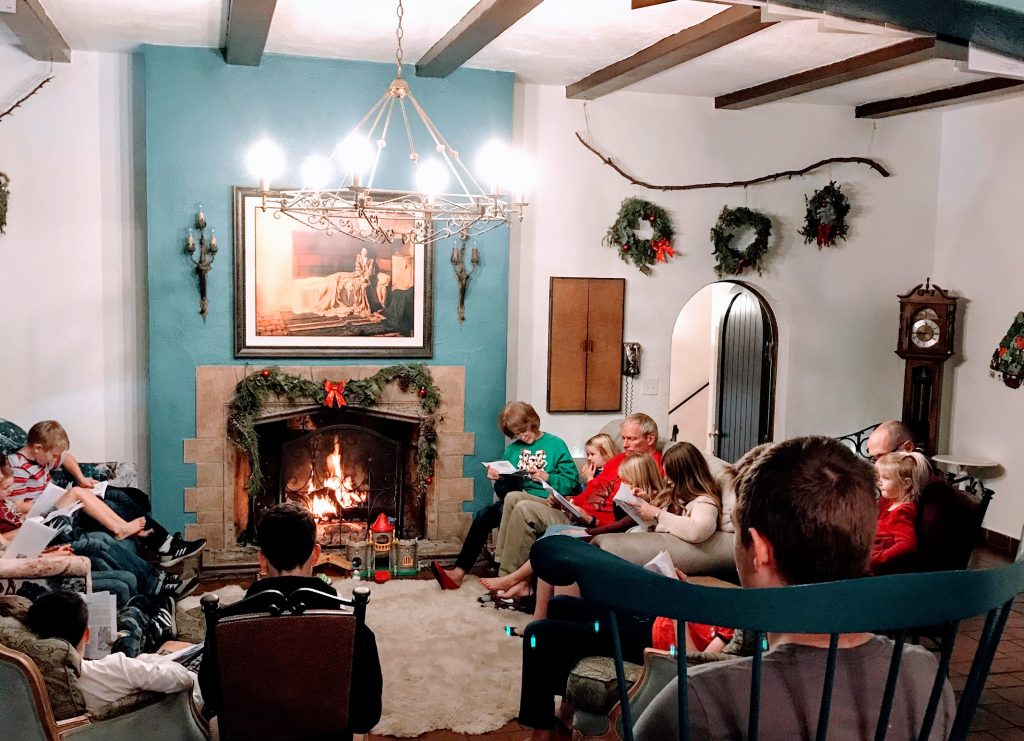
PROS of a gradual approach to decorating are: it really emphasizes visually, in the home, that Advent is a season, there’s less pressure to have everything perfect all at once, decorating becomes a long-term family activity rather than a one-day job, for some moms this will feel like a fun, natural way to approach it
CONS of a gradual approach to decorating are: for other moms, it is more of a challenge. If you like to check boxes and get things done, it can be hard to adopt a slower roll. A focus on homemade things means it won’t necessarily look perfect. Those aspects were hard for me, but they’ve become positives rather than negatives.
I touched on this a bit already, but it’s important enough that I want to emphasize it again here. So, number four is a gradual approach to decorating. It’s more of a change in mindset than a devotion per se, but I’ve found it so helpful. I think the American cultural standard is to drag out the Christmas storage boxes sometime after Thanksgiving (or maybe Halloween) and throw up all the decorations in one fell swoop, then take them down as quickly after Christmas as possible.
Taking a slow, gradual approach to decorating where we add new things weekly, or associated with particular feast days, helps to make Advent that season of waiting and preparation. There’s a very cute fiction book from 1964 called the Twenty-Four Days Before Christmas and in it, they add one decoration to their home each day, and they mostly make them all. I haven’t been able to manage that level of precision, but I do like putting up decorations a few at a time and involving the kids in the process, and trying to incorporate homemade things like paper snowflakes and natural elements like evergreen branches whenever possible.
It works especially well with a nativity set. The first Sunday of Advent, we set up the stable, the second Sunday we put in the animals, the third Sunday we add shepherds and any other extra people, the fourth Sunday we add Mary and Joseph, then on Christmas Eve we add the angel and baby Jesus. The WiseMen arrive later on Epiphany.
Check out Fontanini, Little Drops of Water , or Almond Rod Toys for beautiful, kid-friendly nativity sets with enough pieces to add as you go.
5. STRAW FOR BABY JESUS
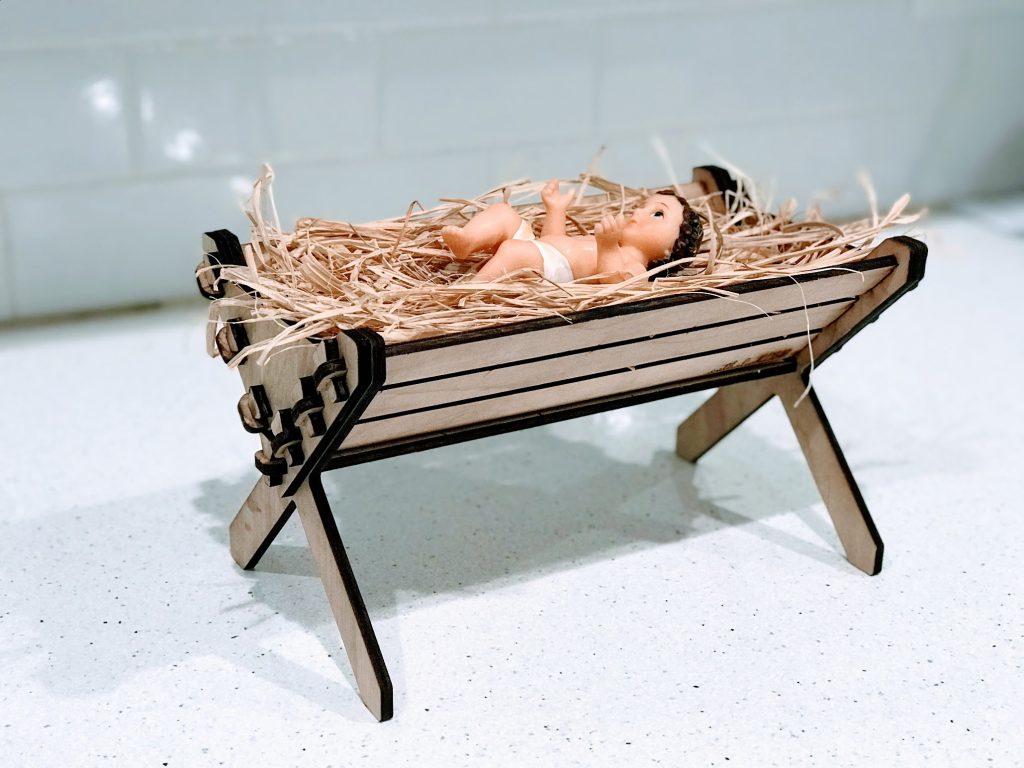
PROS of Straw for Baby Jesus are: it’s motivational and encourages good behavior without the “Santa or elves are watching you” thing, which doesn’t seem as liturgically correct to me, it also emphasizes the idea that we are preparing our hearts as well as our homes for the coming of Jesus at Christmas. It doesn’t require activity-planning or getting kids to sit still.
CONS of Straw for Baby Jesus are: that it’s basically a behavior modification technique and those take some figuring to get right, what is straw-worthy and what isn’t will vary between homes, also there will be days when we forget or days when we don’t deserve any straws, and we always end up on Christmas Eve with all the kids running around doing questionably worthy good deeds to get all the straw in there in time, but that also ends up being pretty cute and fun.
Number five is what we call: Straw for Baby Jesus. The idea is for kids to learn in action about Jesus’ words in the parable: “as you did it to one of the least of these my brethren, you did it to me”. Their sacrifices and good works during Advent, done for parents or friends or siblings, can help to create a soft, comfy bed for the baby Jesus when he is born on Christmas.
We have about a one foot wooden manger that we put on our altar table—but a small wooden crate or a shoe box wrapped in brown paper would work just as well. Also on the altar table, we keep a bag of pieces of raffia or yarn. During Advent, if the husband or I see one of the kids doing a good job on a task, or being kind to a sibling, or doing as we’ve asked them right away, we tell them they can go put a piece of straw in Baby Jesus’ manger. We also let the kids award pieces of straw to each other at evening prayers, if they’ve witnessed or been on the receiving end of acts of kindness.
It’s really amazing how motivating the straw is. They are getting NO reward for themselves. They’re not earning points towards a big prize. All they are getting to do is put a piece of yarn in a box. That’s it. But all my kids, from toddlers to teenagers, appreciate being recognized for good behavior. We do systems like this twice a year, during Advent and Lent, and it’s really helpful for resetting if the kids have fallen into bad habits, and for reinforcing good behaviors. I think it’s more effective, and doesn’t create a sense of entitlement, because it happens only twice a year, and for a set time period each time.
Last thing before bed on Christmas Eve, we bring the Baby Jesus out and place him in the straw and sing “Away in a Manger,” “Silent Night,” and “O Come, Little Children.”
Get the wooden manger set here, or a printable version (yes . . . a PRINTABLE VERSION) here.
6. THE CHRISTMAS NOVENA
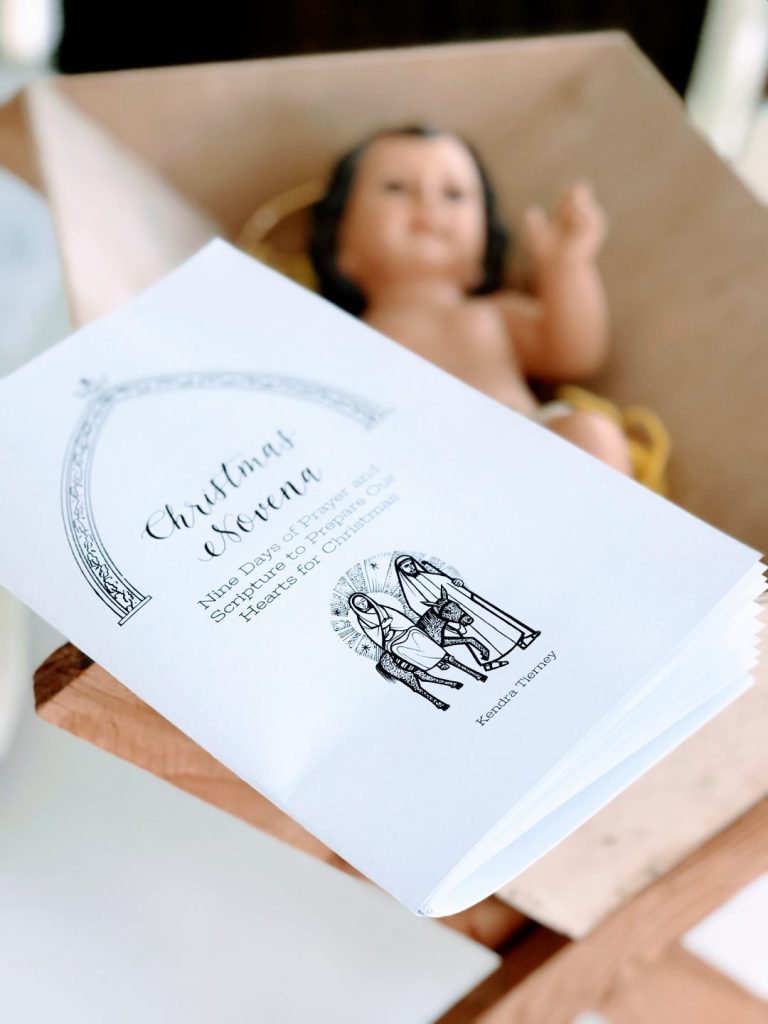
PROS of the Christmas Novena: are that it really seats those last few days leading up to Christmas firmly in prayer and scripture, and if you ask my kids, it has been the most memorable and meaningful liturgical living tradition in their minds, of all the many that we do each year
CONS of the Christmas Novena: are that, everyone ELSE is throwing Christmas parties during those nine days, so scheduling can become a challenge. But I think that’s really also a pro, because it helps us remember that even if everyone else has jumped straight to Christmas, we are still saying our Novena so it must not be here quite yet!
Number 6 is the Christmas Novena. Of all the many things our family does during Advent each year, the nine day Christmas Novena is the most meaningful and memorable. Especially at the beginning of our liturgical living journey, we found the nine day format to be more manageable for our family than the twenty-five day Jesse Tree, which we’ll talk about in a second. The set of prayers and readings we use in our family was composed by an Italian priest in 1721. I love the feeling of being united with the billions of Catholics who have prayed these same prayers over the centuries.
Get the prayer booklet here, or it’s in The Catholic All Year Prayer Companion.
A novena is any prayer or set of prayers said for nine days consecutively, usually ending on the vigil of a particular feast day and often done with a particular intention in mind. So, a Christmas novena could be anything from a Memorare or a Rosary each day, to a nine day set of prayers and readings like the one we use, done in preparation for Christmas. It would normally begin on December 16, and end on December 24. But, because we have often invited friends and neighbors to join us for our novena, and most of them have other family obligations on Christmas Eve, we have sometimes started our novena on December 15, and ended it on the day before Christmas Eve. We just do what works best for our family.
See the video of how and why here.
The schedule that seems to work for us is to start the novena after dinner. I have booklets printed up with all the prayers and readings, and we assign different roles and readings to different people. We sit in the living room, around the fire. We do the novena first, then, while dad or a big kid reads a story aloud to the kids, I set up a small snack for everyone. In theory, I stick to my rule about no Christmas treats before Christmas, and serve things like cheese and crackers and fruit, but in practice, I sometimes find myself putting out homemade goodies that have been given to us by friends and neighbors, and won’t keep. Okay, that happens a lot. But it means we’ve made it pretty close to Christmas waiting to have Christmas treats, so I think it works.
Whether it’s with your whole parish, a few neighbors, or just your family, I really can’t recommend the Christmas novena enough.
7. JESSE TREE
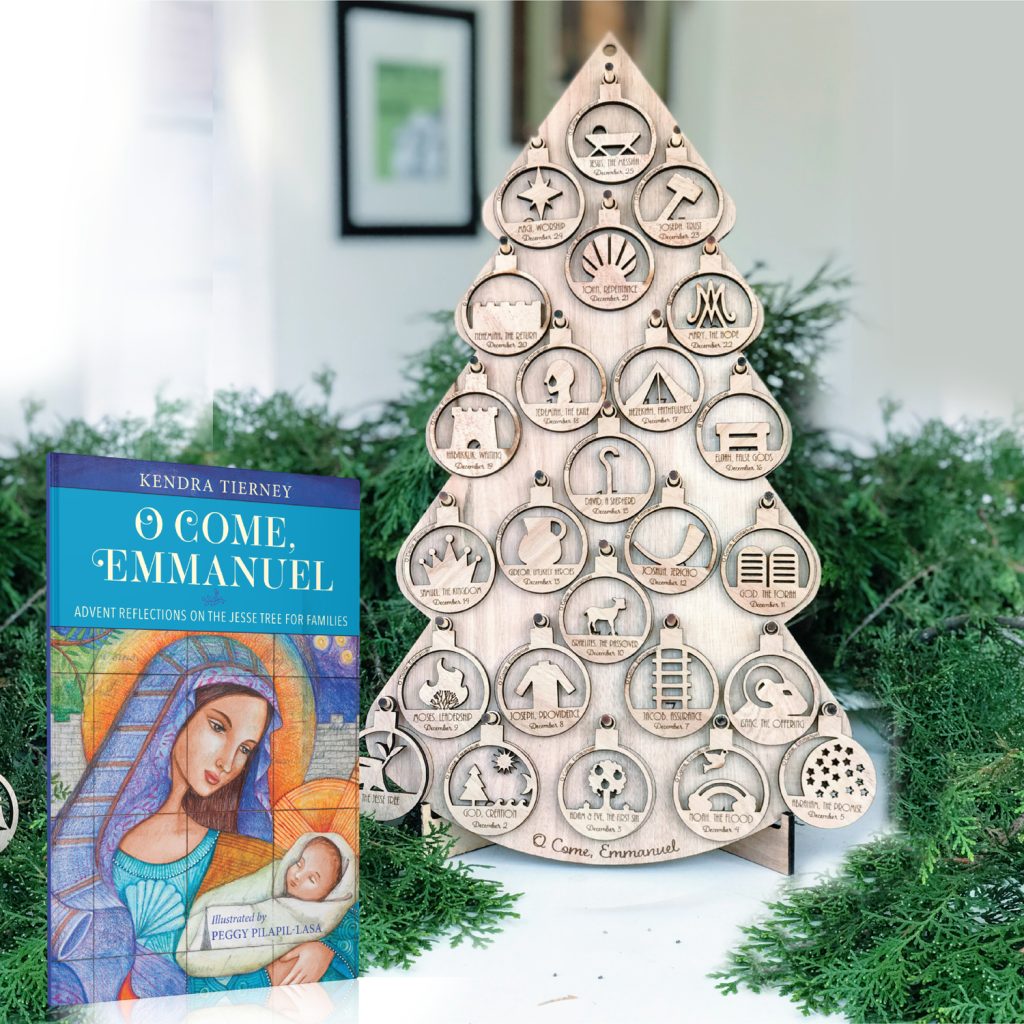
PROS of the Jesse Tree: are that feeling of connection with the long history of our faith, and the fact that it’s ecumenical and a practice we can share with our Protestant brothers and sisters. It can be combined with other traditions, Jesse Tree ornaments can function as an Advent Calendar, and the readings can be done alongside other prayers or novenas.
CONS of the Jesse Tree: are that, even with my adjustments, it’s still a daily time commitment every day for twenty five days straight, and especially when combined with other devotions that’s a scheduling challenge. Still, as with the Christmas Anticipation Prayer, you can skip days or double days if you need to, or abridge it, doing just the reading, or just the reflection, if your audience isn’t up for the whole thing.
Finally, number 7 is the Jesse Tree. The Jesse tree is an Advent activity in which salvation history from creation through the incarnation is traced using (mostly Old Testament) Bible readings and ornaments featuring associated traditional symbols, one for each day of the whole Advent season.
In the Compendium, I report that we tried the Jesse Tree when my big kids were little and it didn’t work for us. Which is true. We did and it didn’t. But then . . . Scott Hahn’s people asked me if I would write a Jesse Tree family devotional for their publishing company. And I was like, “I, um. I, said, I, . . . yes. Yes, I will do that for Scott Hahn.”
So, I did. And it was a great project for me. I managed to solve the issues that had made it especially challenging for us when we tried it the first time. And now we do it and it’s been a great way for us to learn Old Testament history and characters and symbolism.
It’s also been a great lesson for ME in not writing things off forever. It wasn’t a good fit for us in our season of life when we first tried it, but later, and with some personal effort on my part to make adjustments and fix what hadn’t worked, it became a good fit.
Get a simple felt wall-hanging version here, or a free coloring page version (available with new or previous purchase of the book). Get the book at the St. Paul Center or from Barnes and Nobel or from Amazon(it will be back in stock on the marketplace soon).
Okay, so there’s your intro to various Catholic Advent traditions. Of course, there are also traditions associated with particular feast days and a whole lot more that I didn’t get into today, but I hope it’s been helpful as an overview. Most of this information is from The Catholic All Year Compendium. See that book for deeper dive into all of this liturgical living in the home stuff. I hope you’re feeling inspired to try to incorporate some of these into your family’s Advent season, and empowered to do them in a way that will work for your particular family and circumstances and season of life this year.

